Humble Beginnings?
I grew up in the San Francisco Bay Area, on the peninsula in Belmont, California. If you’re familiar with the landscape, you’ll know the peninsula nestles up against the Santa Cruz Mountains. This mountain range, in my humble, unbiased opinion, provides some of the best single track running trails in the world. Given this information, you’re probably assuming that growing up, racing high school cross country in some of these parks, that I was exploring these endless, undulating trails— revealing worlds unknown to a young, wide eyed kid.
Well you’re wrong.
I trained on the El Camino every single day– the busiest, traffic light ridden road in the Bay Area.

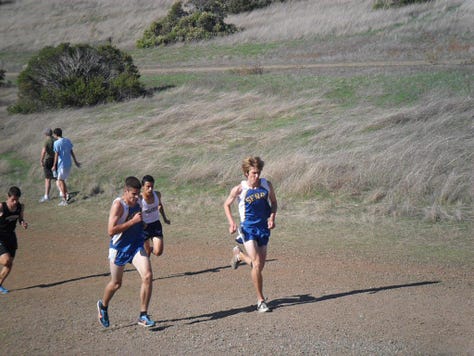
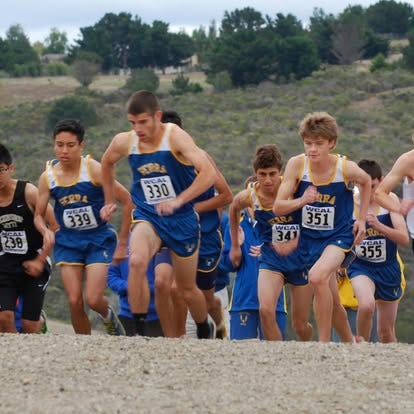
My eyes weren’t opened to the endless wonders of Bay Area trail running until joining the Santa Clara University Cross Country team. It was my freshman year when my eyes were opened to these incredible, seemingly secluded (we were always within 5 miles away from the 280) forests with endless, winding trails.
Huddart Park
Rancho San Antonio
Windy Hill Preserve
Alum Rock Park
Nisene Marks
These were some of the state parks we frequented for our team practices. We piled in vans at 7 AM every morning to drive to these iconic spots before speeding back down the 280 in the SCU Athletic Department’s Toyota Siennas to catch our 10:20 am classes. It was always worth it, regardless of how late I was to my seemingly pointless History 119 class. The morning fog rolling over those mountains from the Pacific Ocean every day had to facilitate some of the most pure and crisp air my lungs could take in. We all needed it, too, due to the one small detail I haven’t mentioned: they’re the hilliest f****ng trails on planet Earth. That is a scientific fact.
It was on these brutal treks that I became a hill runner. My current training partners frequently hear of the “Santa Clara Special,” which is classified as any run where the first half involves running up a mountain, and the second half is running back down the aforementioned mountain. The best and worst part? The climbs were always a pissing contest among teammates. We ran as hard as we could up the big climbs. Every single time, without fail. This tradition was brought on to me on the first weekend at Huddart Park in Woodside, running up “The Ridge,” where I was dropped immediately by the stronger and more calloused upperclassmen. It’s a rite of passage– by the time I was an upperclassmen, I was tempting incoming freshman with a “pitter patter” up the Ridge every Sunday, only to put in a world class surge the second the incline was greater than zero percent. Nothing is more freeing than dropping the shit out of your friends on a climb. I still get no greater rush from running.
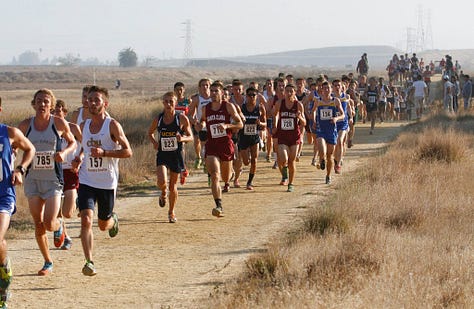

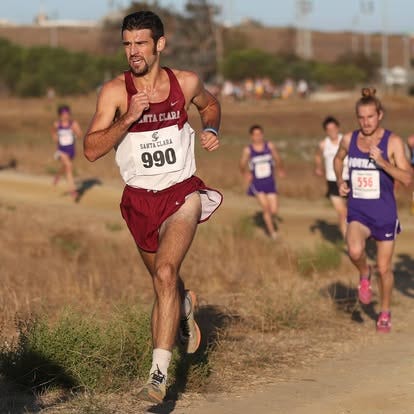
Do I Have Trail Chops?
I tell this story because, more recently, I’ve had multiple people ask if there’s ever been any interest in trail racing, and if I’d be good at it. My answer? One unsuspecting inquirer got the response “I would literally destroy everyone at trail racing.”
Now that’s a stupid, pretentious answer. Of course I wouldn’t destroy everyone at trail racing. I do think I’d be pretty frickin’ good at it. Given the original nature of this newsletter, this prompts the question: could I get a shoe sponsor if I were a trail runner?
This won’t be an opinion piece about my abilities on the singletracks. I’ve recently been more exposed to the trial scene– paying somewhat close attention to big races and how the pros operate. My smart and beautiful girlfriend, Roxanne, works for HydraPak, who sponsors a handful of trail athletes, and often talks about trail racing. Looking at other outdoor brands, some even local brands in Boulder, most have sponsored trail athletes, and only few or no sponsored track or road athletes.
The Trail Scene, 2025 AD
Apparently, up until maybe(?) five years ago, there was no money on the trails. Only a handful of athletes made livable income off of their running contracts, and I could probably name them just based on who I’ve heard of through media attention (Kilian Jornet, Scott Jurek, Jim Walmsley, Courtney Dauwalter? I know there were more). But given my total lack of attention to trail running until about six months ago, it seems like there’s a HUGE boom in sponsorship opportunities for trail runners, and that’s due to the fact that every trail runner I see nowadays is rocking a pro kit in competition. On top of the shoe/ apparel sponsorships, based on what Roxanne talks about, secondary sponsorships are on the rise as well. Look at any endurance specific nutrition brand’s Instagram page, and there’s a trail runner spotlight in there. I could be totally wrong; all of this could be totally skewed based on my lack of immersion in the scene. Regardless, in honor of my trail runner friends, I’ve developed reasoning why brands might see a successful trail runner as a more attractive athlete to sponsor than a track athlete.
Before diving in, it’s important to clarify what I mean when I say “trail runner.” It’s a broad term that I’m using which doesn’t cover the full scope of the non track/ marathon running world. For the sake of this read, when I say trail runner, I’m really referring to this range of athletes:
Trail runners – who compete up to the marathon distance on the trails.
Ultra marathoners – who compete in distances that go beyond the marathon; 50k, 100k, 100 mile races, for example. Terrain ranges across all surfaces (except I think an ultra on a track is dumb).
Alpinists/ Mountaineers – is that what we call them? This is borderline speed hiking in my book, but I’ve seen videos of Kilian Jornet running along mountain ridges, and that shit is real, legit running. I know there’s overlap with ultra runners dabbling in activity that brings my crippling anxiety of heights to the forefront of my mind. Anyways, they fall under the umbrella of who I’m talking about.
Now that we’ve clarified the terms, we can dive into this. Here’s why elite trail running might already be overtaking track in sponsorship opportunities.
You Too, Can Sponsor a Trail Runner
Historically, there have been traditional running brands with sponsored athletes in trail running– Nike, adidas Terrex, HOKA, New Balance, etc. However, the major brands that dominate the general outdoor space– The North Face, Salomon, La Sportiva, for example, do not have a presence of sponsorship in track and field. The pool of potential large brand sponsors covers both the running and outdoor categories in trail running, making the opportunity for sponsorship higher. These deals don’t touch anywhere near the superstar track and field deals, but an All-American in cross country who sees no potential (or is identified as such) on the track or roads after graduation can probably apply their talents to the trails, which we’ve seen more of recently.
The pool of athletes in trail running has grown, and college cross country & track athletes are making the jump from college distance running straight to the trails– applying their talent gets their foot in the door, and they can focus on training the endurance and technical skills as they progress in distance and learn the terrain. Successful trail athletes and ultra runners like Adam Peterman and Hayden Hawks (both HOKA trail athletes), through my lens, were the first crop of guys that went straight from NCAA Cross Country All-Americans to the trails, and it seems to have paid off massively– with sponsorship, national titles, and access to the highest level of the sport across the world. More recently, athletes like Lauren Gregory (Nike) and Anna Gibson (Brooks), who were even forces to be reckoned with on the NCAA track scene; probably good enough to get sponsorship for track, opted for the trails, and are finding immediate success. When thinking of athletes in the NCAA present day, especially with current issues like roster limits, NIL sponsorship, and overall a massive uptick in what it means to be competitive, I don’t see a bright future in track for many of those who aren’t the top dogs. Not to be pessimistic, as I fell beneath this category leaving college; but it's already difficult enough to pursue running professionally as a professional athlete. Pro athletes aren’t coddled like we were in college with unlimited resources at our fingertips. That, paired with the ever growing burden of “getting our life going,” those who want to keep the dream alive might start thinking about what possibilities lie outside the track.
Based on what I have seen recently, the potential for income and access to more resources for trail athletes is from secondary sponsorships. Nutrition companies are popping up left and right– the energy gel industry alone will surpass a $1 billion market by 2030, signaling the increasing demand for proper nutrition in exercise, especially in endurance sports. It’s an exciting time to be in running, and I’m sure runners and non-runners alike want to capitalize.
Recently, Skratch Labs, a nutrition company based near my home in Boulder, CO, just announced their Skratch Labs Racing team, which consisted of eight athletes– four cyclists (road and gravel) and four runners— all trail and ultra runners. Immediately I’m thinking, “why no track athletes??” I’ll tell you why.
Team Soft Surface
We say (and I have even said in this newsletter) that runners are walking billboards. They’re the best ambassadors for the product a brand is trying to sell, because they’re running fast or far in that apparel in real time. But are track athletes REALLY walking billboards during competition? For a racing spike, yes. Everything else, not really.
Trail runners (and this has applications to triathletes and cyclists, too), are the ultimate product testers put on display for everyone to see. They take their sponsor’s product through the wringer when it comes to training and competition. An amateur running a 100 mile race in a pair of racing shorts puts their ultimate trust in the brand’s product quality– if the shorts make you chafe easily, they’re never using that brand’s shorts again. It makes me think of why brands like Patagonia and The North Face started– there was a real demand for high quality product to meet the elements that their core audiences immersed themselves in everyday. Nobody wanted to explore the extremes of the Earth in a cotton tee; they needed good product to withstand the elements, to meet the physical demands of terrain and how one traverses it. Especially for ultrarunners, the athletes need the best and most accommodating gear to run as unbothered as possible. Their events and their movement require a certain standard of product that can keep up with their abilities, and stay out of the way. This gear not only includes clothing and shoes but also accessories – water, food/ nutrition, bottles, flasks, tech– all of it needs to match the level of athlete when used. The wrong socks can completely derail a 50k race. If you’re an amateur looking to cover that distance, who are you going to trust? The salesman at the store, or the athlete running the same distance in a pair that works? As a sales rep at a shoe store six years ago, I only referred to real life, pro athlete examples when justifying the legitimacy of product.
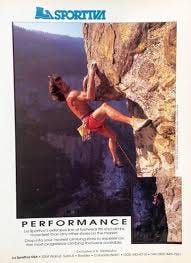
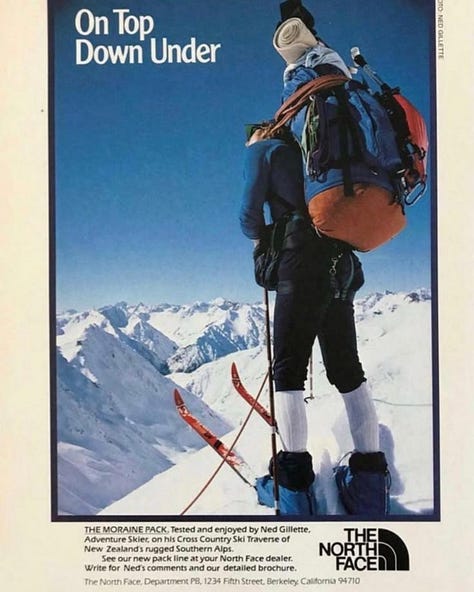
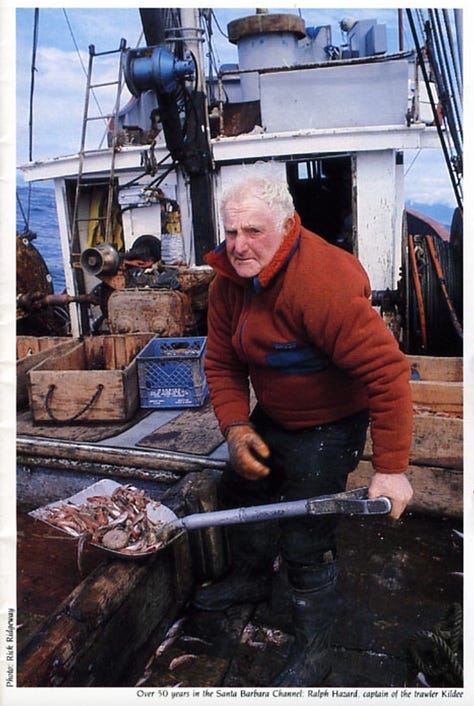
These points refer back to the overarching argument in I’m Not Interested in Anything You’re Selling— the product needs to be an extension of the athlete. Roxanne tells of how athletes frequently reach out to HydraPak to solicit sponsorships or product, because their go-to flask in a race is HydraPak. The flask acts as an inconspicuous accessory to the athlete during a race– they hardly notice it’s there, but it’s always there when they need it the most. Referring back to my example with Skratch, is anyone on the track taking high carb fuel mix during a race, when the “product matches performance” test matters the most?
No.
It happens on the trails, though. In front of plenty of eyes to see in real time. This dynamic is why these smaller brands have moved to the trails first. It’s a way to prove to your intended audience that your product can withstand the ultimate tests– the shorts won’t chafe, the flask stays in your vest, the gels won't give you GI issues, and the lugs on your shoes have a lasting grip.
Track athletes and marathoners create this dynamic too, just on a smaller scale with fewer products. Clearly, legitimizing footwear is priority number one for a running focused sponsorship– it’s the biggest driver in the running industry, and priority number one for every large shoe and apparel brand. This is why the big shot track & field athletes make damn good money. Marathoners are now tasked with legitimizing super shoes, as the market for these among amateurs has increased tremendously. For track athletes, though the spikes don’t bring in big time revenue for the brands— it’s still proven to be an important product to have in the lineup, where runners of any level can often create personal identities through brands. If you’ve run a couple marathons in Nikes and want to take a stab at a local track 5k, you’ll probably buy Nike spikes if you want to train and race in spikes.
Nutrition is becoming more and more of a priority in distance running for track athletes, as many athletes will overlap with marathoners in training, and sometimes racing. I would argue that track-focused distance athletes are starting to fuel more like marathoners in their training, and the demand for quality nutrition is increasing. Ultimately, as I mentioned, that is not on display in front of the masses though, unless a track athlete uses their platform or the brands platform to deliver that type of education and content. Slightly manufactured; but if done well, can deliver a similar message.
Something to Think About
At the end of the day, the biggest focus for brands is capitalizing not on one athlete’s specific audience, but the brand’s intended audience as a whole. Today, that’s easier to identify, as the “mass participation” crowds at marathons and trail races are increasing every year. These events act as a microclimate of the popular trends for the consumer— you can tell what shoes, singlet, and gels are the most popular just by watching a marathon on the street.
With this in mind, it’s not difficult to believe that marathoning and trail running can be more lucrative for their elite athlete fields than track due to the amount of people that participate in the same races. Big events draw high participation numbers, drawing a bigger prize purse for the elite athletes. Racing on the same course as the best is not only cool, but it is equal parts inspiring. Unfortunately, everyone that shows up to a track meet is only there to spectate, and it can create a barrier between fan and athlete. Does this lead to a weaker association between sponsor brands and a consumer’s willingness to buy?
I want to leave this question for open discussion. I’ll tackle it more next week, but would love to hear your input.
To end, I’ll leave you with a couple of cool things I’ve seen in the endurance space this past week:
Alex Yee started a YouTube channel– the first episode revolves around his decision to race the London Marathon. It will be interesting to see how the 2024 Olympic Gold Medalist and World Champ in the triathlon’s content stacks up to the current running youtubers, and soon after the triathlon specific content. A New Balance running athlete (if that’s the best way to put it?) there doesn’t seem to be any sponsor plugs– although they did blur out the coach’s Nike logo on his team GB jacket during a couple scenes.
The Pyongyang Marathon was held for the first time since Covid last weekend, bringing in tourists for the first time in six years. The men’s race was won in 2:12:08 by Pak Kum Dong of North Korea, and the women’s race won in 2:25:48 by Jon Su Gyong. It seems that a majority of North Korean elite athletes were rocking Li-Ning super shoes.
I got to join my good friends at CoffeeClub on their podcast last week. We talk about the newsletter, Grand Slam Track, and where my future lies in running. Go ahead and give that a listen on YouTube or wherever you get your podcasts. They’re good guys, worth a listen for any episode.
Thanks for your time as always. I’d love to hear your thoughts and opinions in the comments or on the substack network. The more diverse opinions, the better the discourse. Thanks for following along and contributing to the culture.
Lastly, If you’re interested, I’m racing the BAA 5k this Saturday the 17th, as a part of the Boston Marathon weekend. If you’re around, let me know— I’ll try to organize a run if there’s interest.
Cheers mates,
Joey



Joey Bags,
I second what Stu says about checking out Boulder Boys show and also being a more recent track fan. Boulder Boys is largely modeled after/inspired by Coffee Club and inspired me to start listening to Coffee club a few months ago.
I'm curious if you feel that the switch to NIL deals in collegiate track/XC will squeeze out more Adam Peterman/Anna Gibson types towards trail running right out of college with more and more foreign athletes coming in to take NIL spots? It seems it is now much more lucrative to run collegiately instead of coming up through the ranks in whatever their home countries are? I haven't been a college track/xc fan long enough to tell if this is a new thing because of NIL but from my new fan perspective it seems like there are a lot more east africans competing in the NCAA champs than there used to be.
It goes without saying that me and many others would love to see you test your chops at an out of season trail race or even a VK like Broken Arrow (end of June which I think is during your season but one of the most competitive in the US) that would be low impact and not affect your steeple goals too much. I'm not sure if you know this, but a lot of Trail running GOATs come from collegiate steeplechase (max king and Jim walmsley come to mind but I'm sure there's more) so there seems to be some strange connection between the two skillsets.
Keep up the great writing (it's a joy to see you in the email inbox each week) and best of luck at Boston!
Really enjoyed this and your Coffee Club pod. I am a fairly new track fan, but a long-time trail runner. If you haven't heard of them, you should check out the Boulder Boys (podcast), they are some of the best trail runners in North America and at least two of the guys (Seth Ruhling & Matt Daniels) are huge track fans. They seem like top guys too.